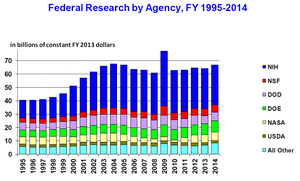This article needs to be updated. (December 2017) |

The science policy of the United States is the responsibility of many organizations throughout the federal government. Much of the large-scale policy is made through the legislative budget process of enacting the yearly federal budget, although there are other legislative issues that directly involve science, such as energy policy, climate change, and stem cell research. Further decisions are made by the various federal agencies which spend the funds allocated by Congress, either on in-house research or by granting funds to outside organizations and researchers.
Professor N. Rosenberg, one of the pioneers of technological innovation research, pointed out that industrial research laboratories (R&D), if not the most important institutional innovations in institutional innovation in the 20th century, are also one of the most important institutional innovations. Although not the first invention of the United States, this system has a wider spread and stronger influence in the US economy than in other countries.
The United States devoted 2.8% of GDP to research and development (R&D) in 2012. The private sector contributed two-thirds of the total. The Obama administration had fixed a target of a 3% ratio by the end of his presidency in 2016.[2]
- ^ "The 2014 Budget: A World-Leading Commitment to Science and Research" (PDF). Office of Science and Technology Policy. Retrieved 19 March 2014.
- ^ Cite error: The named reference
:0was invoked but never defined (see the help page).
© MMXXIII Rich X Search. We shall prevail. All rights reserved. Rich X Search
